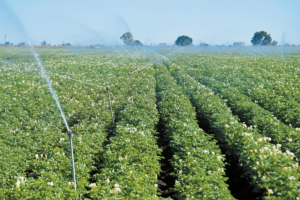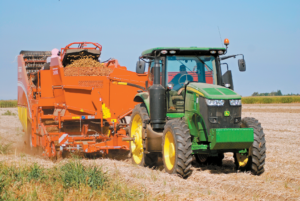Sep 28, 2023Rising California potato production reflects nationwide trend
After a four-year decline in potato production nationwide, this season’s crop appears poised to buck the trend, spurred by strong demand and improved water supplies.
While higher processing contract prices are driving much of the increased acreage, California’s mostly fresh-market growers may see prices decline once harvest starts elsewhere, said Almuhanad Melhim, a fruit and vegetable market analyst for Rabobank’s RaboResearch division. “In the potato market,” he said, “the fresh side and the processing side are intertwined.”
During the past few years, processors have been short on russet potatoes that go into french fries, so they snapped up fresh-market russet supplies, driving up fresh prices. To encourage more processed potato production this year, processors increased contract prices substantially.

California produces fall and spring fresh-market potato crops in the southern San Joaquin Valley. Growers in the region typically enjoy prices two to three times those of Idaho russets because they fill specialty markets and hit a window when other states aren’t harvesting, Melhim said.
“Because of a short supply this winter, they saw an even better improvement in price,” he said of California producers. “There was a general improvement in potato prices in all states because we’ve had a very short supply of fresh, and because of reduced acres and the effects of the drought.”
This season, the nation’s growers planted 949,000 acres, up from 901,000 in 2022, according to a June 30 acreage report by the U.S. Department of Agriculture National Agricultural Statistics Service. In California, potato growers planted 23,000 acres this year, up from 19,000 in 2022. Much of the state’s increase is due to an improved water picture, Melhim said.
With the expected jump in nationwide production, he said he expected fresh-market prices to decline 15% to 20% year over year. However, that could change depending on yields, quality and fall weather as harvest progresses in the large potato-producing regions, including Idaho, the Pacific Northwest and Colorado, he said.
Siskiyou County farmer Ed Staunton, who farms near Tulelake, said he has seen prices fall with higher acreage in the West. In the Klamath Basin, growers plant a mix of fresh-market and chipping varieties in the spring and harvest in the fall.
“We’re definitely seeing the effects of (increased acreage), so the market has been dropping drastically from the real high,” he said. “I just hope that the darn thing stops going down.”
Melhim said many growers have fared well because input costs have leveled out or even decreased. He added, “The last couple of years, the fresh guys made more because fresh-market prices went up higher than contract prices, so they were able to make good returns.”
Growers select potato varieties based on traits and suitability for end uses. About 25% of total production nationwide goes to the fresh market, another 23% for potato chips and most of the remainder to french fry processing, according to figures by Potatoes USA, a marketing and research organization. Russets are sold fresh for baked potatoes or processed into french fries.
In Kern County, the state’s largest potato-producing region, growers plant mostly fresh-market varieties with less acreage devoted to chipping varieties, said Jaspreet Sidhu, University of California Cooperative Extension vegetable crops farm advisor.

Kern County potato growers typically plant two crops per year, with the spring harvest being much larger than the fall. The spring crop was harvested in late June. Sidhu said the quality was good with tubers trending toward smaller sizes.
As with many other crops in the state, she said Kern County potatoes were about a week to 10 days behind schedule maturing because of planting delays and cool winter growing conditions.
“As far as diseases, I think we had a pretty good year and didn’t have any surprises,” Sidhu said. “We had a few cases of late blight and a little bit of thrips but no soft rot. When we’re harvesting in June, there was not extensive blight, so I think we did pretty good in terms of disease.”
Overall, Sidhu said yields were off an average of 10% to 15%, although some growers saw only 5% reductions.
Tulelake-area growers began harvesting in mid-September, a few days ahead of normal, Staunton said. Although the region received about 200% of average precipitation during the winter, he said conditions began to dry just before planting.
“It was cold, cold, cold, and when we started to plant, it got nice and stayed nice,” he said. “We had a real nice growing season with only a couple of warm spells, but nothing crazy.”
With plenty of rain, Staunton said farmers thought they would receive full water deliveries from the U.S. Bureau of Reclamation’s Klamath Water Project. But ongoing mandated diversions for environmental uses reduced deliveries to agriculture.
Surprisingly, the Stauntons’ farms received about 2 inches of rain in mid-August from the remnants of Hurricane Hilary.
“In August, we never see rain, and our average for the year is only 10 inches,” Staunton said. The rain promoted a small amount of fungal disease, such as water rot and pink rot, but “nothing I was worried about,” he said.
Klamath Basin farmers began digging specialty potatoes, including reds, yellows and chipping varieties, in mid-September. Russet harvest follows, and he said he was excited by what he saw from a few samples.
“Our test digs are showing really good yields,” Stanton said of russets. But he also has been growing potatoes long enough to know that test digs may not accurately reflect a field’s total yields.
About 50% of Staunton’s production is organic, and he said his Northern California location works well for growing potatoes for this sector.
He also grows chipping varieties for Gold Dust, a local chip marketer. Potatoes too large for chips go to In-N-Out Burger for french fries.
— California Farm Bureau Federation







